

FICTION | POETRY | NONFICTION | ART | REVIEWS
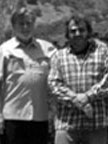
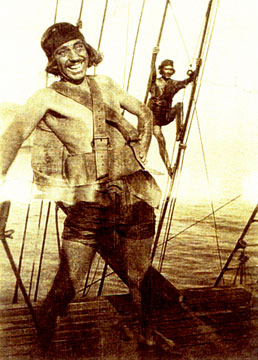
Eddie storms the ship in The Black Pirate (1926). (Courtesy collection of Gilbert LeVeque)
PART II
Upon receiving his release from the United States Army in January 1919, Eddie LeVeque returned home to Los Angeles, intending to resume his career in motion pictures. His timing couldn’t have been worse.
Eddie returned to find Hollywood still reeling from the worst epidemic the United States has ever known, the Spanish flu epidemic of 1918-1919.
The outbreak had peaked in October of 1918, a month that saw over 195,000 Americans sicken and die. Three of Eddie’s former Keystone co-workers were among those who passed away that autumn. George Binns, Arthur Moon, and Wayland Trask all fell victim to influenza.
The Los Angeles County Health Department ordered the wearing of masks at the workplace and placed limits on the number of people who could work or gather in one area in an attempt to halt the spread of the plague.
When the epidemic reached its zenith in October, the National Association of the Motion Picture Industry agreed to a government request for a shut down of all movie studios. Movie theaters were also closed down, lessening the demand for new films.
When the studios resumed film production in late November, it was on a much smaller scale. This was the Hollywood Eddie came home to two months later.
In need of employment but unable to find full-time work in the downsized film industry, Eddie took a job selling real estate, accepting small parts in motion pictures whenever he had the opportunity. The real estate job paid the bills, but wasn’t his career of choice. Eddie waited for things to pick up in the film industry, and in February, 1920, was hired by Metro Pictures. Although Eddie’s stay at Metro was brief, it was memorable. He recalled:
I returned to Hollywood and went to the Metro Studios (later MGM) on Cahuenga and Romaine.
Valentino and Alice Terry were there with Rex Ingram the director shooting Four Horsemen of the Apocalypse. I became an assistant director with him, and good friends. We had both been fliers, but he was in the British Army and I was a cadet in this country. Since there was no sound, Mexicans could play French or Latin soldiers and character parts of all kinds.
When not on the set, Eddie could be found at work in the Metro film editing department. (1.)
With experience in so many facets of movie making, Eddie decided to start his own production company. In early 1921, he departed Metro and became a partner in Kamera Pictures, a subsidiary of Harter-Wall Productions. In 1970, Eddie looked back upon this venture.
When I left Metro, I joined up with a Pathe cameraman who was out of work but had a movie camera of his own. We started making short advertising films for theatres, the forerunners of TV commercials. We branched out into travelogues and later more ambitious two-reel Western comedies. These were shot around Bakersfield, and we sold them state by state.
Some of the actors we found in this way later became featured players in bigger films. One of these was Skitter Bill who became a star in his own westerns. (2.)
Eddie’s official title for Harter-Wall Productions was Exploitation Manager, but the trade publication Camera! provides a more detailed description of what Eddie actually did for the company. Between October 22, 1921 and February 1, 1922, Eddie was listed on Harter-Wall’s production schedules as casting director, scenarist, assistant director, schedule director and director. He may have also acted, but since the films have been lost to time, it is impossible to tell.
Kamera Pictures never caught on as well as Eddie had hoped and by mid 1922, he had returned to Hollywood, looking for ways to subsidize his Kamera Pictures paycheck. Eddie immediately found work as an extra and bit player. One of his first jobs was working for Allan Dwan in Robin Hood. The movie turned out to be one of Douglas Fairbanks’ biggest hits, but Dwan later recalled the depressed economic climate in Hollywood during the filming.
(Robin Hood) was made at a time when there was a complete lull in the business—no other studio was working. Therefore a lot of those people in the crowds were some of the best actors, writers and technicians in the business; they all came over to get a meal ticket. It was one of those times when all of a sudden the box office fell apart—the public deserted the picture business. The only answer to it is that the pictures we were turning out were lousy. So Doug put his own money into Robin Hood because he couldn’t get financed. It opened Grauman’s Egyptian Theatre, which had just been built, and was a terrific success. (3.)
During the filming of Robin Hood, Eddie became acquainted with Charlie Stevens. Stevens was a grandson of the great Apache chief Geronimo, and a member of Douglas Fairbanks close knit stock company. The two would work together again in the 1926 Fairbanks epic The Black Pirate and became life-long friends.
In early 1928, Eddie took a full-time position with Paramount. Though his main assignment was film projectionist, Eddie used his knowledge of Spanish to become involved with the production and distribution of Spanish language films in both the United States and Mexico.
Shortly after joining Paramount, Eddie married Florence Gilbert. The Paramount Studio News of May 9, 1928, reported the event:
Cupid Again. After an absence of some weeks, Dan Cupid has returned to his favorite hunting ground—the Paramount laboratory. This time Edward LeVeque, laboratory projectionist, fell victim to Cupid’s aim. On Sunday, April 29, LeVeque and Miss Florence L. Gilbert were married at the First Baptist Church.
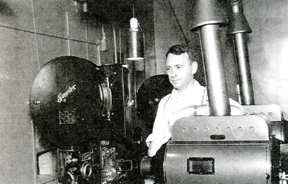
Eddie at work in the Paramount film lab. (Courtesy collection of Gilbert LeVeque)
Mrs. LeVeque is a well known artist and fashion designer. At one time she created the art titles for the independent productions made by B.P. Schulberg before his affiliation with Paramount.
The many studio friends of the couple extend sincere best wishes for their future happiness.
Newly wed and wishing to start a family, Eddie put down roots at Paramount and put his love of performing aside for the security of a weekly paycheck.
Eddie became an expert at his new vocation and was a charter member of the Studio Projectionists Union. Labor issues and leftist politics were both hot potatoes with Paramount executives. Subsequently, when Eddie began writing a column for the Hollywood Spectator in 1937, it didn’t go over too well. Even though the articles were generally reviews of Spanish and Russian language films and critical essays on the use and misuse of sound in motion pictures, the leftist viewpoint of the paper caused alarm at Paramount. The studio forced LeVeque to use the pen-name Don Susano in his Hollywood Spectator writings. Given the strong anti-left sentiment in Hollywood at the time, Eddie had no choice but to comply. He turned his writing talents to more studio-friendly pursuits and began submitting gags and scripts to Paramount. He also wrote and translated Spanish dialogue for the studio research department.
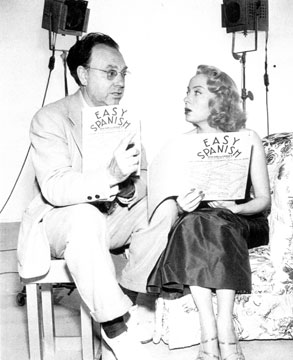
Actress Audrey Totter gets a lesson in Easy Spanish. (Courtesy collection Gilbert LeVeque)
In 1944, Eddie put this skill to good use and wrote a book called Easy Spanish. The book featured Eddie’s revolutionary theory on learning how to speak Spanish quickly by linking common English and Spanish words. The cover featured endorsements by stars such as Bob Hope, Bing Crosby, Alan Ladd, Claudette Colbert, and Loretta Young. The book sold more than 20,000 copies.
Later, LeVeque released a Spanish version of his book with the title Easy English. He was often called upon to serve as a dialogue instructor in films where American actors needed to speak with more authentic accents in Spanish-speaking roles.
Eddie left Paramount in 1947, the dawn of the age of television. Yet, it would not be television but rather in radio where he would begin the next stage of his career.
Creating the radio persona of Señor Don Eduardo, Eddie began a long run as a disc jockey on KALI, a Spanish language radio station. By 1952, LeVeque had become a fixture at KALI and it looked like radio would become his permanent career. Then one night Eddie received a call from his old Keystone pal Eddie Gribbon that would change the rest of his life.
The Masquers Club was staging a benefit show to aid the Motion Picture Relief Fund and wanted to include a segment featuring some of the old Keystone Kops. Gribbon called to see if LeVeque would like to join the group, which included Hank Mann, Heinie Conklin, Chester Conklin, and Jim Finlayson. He immediately agreed and was onstage at the Pantages Theater with the Kops on the night of September 24, 1952.
It had been thirty-five years since Eddie last worked at Keystone. The benefit opened a flood gate of memories and Eddie reflected upon how much he had enjoyed working as a Keystone Kop and realized that he still loved to perform.
Eddie continued his radio program throughout the 1950’s, but also resumed his career as a character actor, performing both on stage and on television, where he frequently did Spanish voiceovers of commercials originally filmed in English for Five Star Productions. The late 1950’s saw a demand for LeVeque’s services in motion pictures. Among his many appearances were small roles in Gigi (1958), It Started With A Kiss (1959), and Can-Can (1960).
When Mack Sennett died in 1960, Eddie was among the estimated 175 friends and former Sennett employees who came to pay their last respects. While Sennett was alive, his birthday had been celebrated each year with a gathering of all the surviving Keystone alumni. With his passing, it was assumed that Sennett and Keystone would soon be forgotten and fade into film history.
Many of the old Keystone players were in favor of continuing the yearly gatherings, but with Mack gone, they needed a focal point. The man with the plan was Eddie LeVeque.
In 1962, Eddie purchased the rights to the Keystone Kops name from the Sennett estate and had them copyrighted. Having obtained U.S. Copyright B.B. 23011, Eddie further strengthened his ownership rights to the Keystone Kops by obtaining a U.S. Patent Registered Trademark S.N. 366372 … 967240.
LeVeque explained his acquisition in a 1970 article written for Hollywood Studio Magazine:
In Mack Sennett’s last will and testament there is no mention of the Keystone Kops or the name Keystone, nor when the will was probated shortly after he died. In fact, there is no paper or document in existence stating Mack Sennett retained an interest in Keystone.
Sennett sold all his interest in Keystone to the Triangle-Keystone people in June of 1917. He started producing movies under his own name, Mack Sennett Comedies which were first released by Paramount.
When Triangle-Keystone went out of business, the name was all but forgotten until I re-copyrighted the name with the idea of keeping it active. In fact I have more than complied with the requirements which the law demands. (4.)
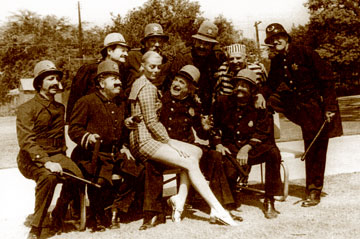
Eddie amd the Kops interrogate a suspect. (Courtesy collection of Gilbert LeVeque)
Eddie later summed up what it took to acquire the Keystone Kops name: “Three lawyers, a patent attorney and a lot of money!!” (5.) With the rights to the Keystone Kops now in his possession, Eddie began the process of re-establishing the comic police force. In the years since Sennett had sold off his interest in Keystone, there had been numerous attempts to bring back the Keystone Kops as a comedy troupe, but all turned out to be one shot deals. Keystone Hotel (1935), Hollywood Cavalcade (1939), Abbott and Costello Meet the Keystone Kops (1952) were a few of the more notable examples.
For years, various producers had kicked around the idea of featuring the Kops in a weekly television series, but nothing ever came of it. A group of old Kops including Chester Conklin, Hank Mann, and Heine Conklin often guested on television shows during the 1950’s, but there never was any formal structure to the group.
Eddie sought to change this. The “coming out” party for the LeVeque-led Keystone Kops took place on January 19, 1962, the first “uniformed” reunion ever held by the Sennett alumni. Eleven former Kops were in attendance. Eddie Gribbon put the gathering in perspective; “We used to get together with Mack to celebrate his birthday every year but this is the first reunion since he died.” (6.)
The event received major media coverage, including a write-up in Life magazine. The LeVeque-led Keystone Kops were a hit.
From 1962 until 1965, Eddie seemed to be everywhere. He still worked in radio, guested on various television shows, such as Arrest and Trial (1964), and performed in plays with small theater groups like the Company of Angels. Eddie also continued to be sought after as a character actor in motion pictures. Among his big screen appearances were Two Weeks in Another Town (1962) and Wild and Wonderful (1964).
With so much going on in his solo career, Eddie initially didn’t have enough free time to launch his Keystone Kops as a performing troupe. In the early 1960’s, the occasional Keystone Kop events always featured actors who had worked with Sennett at Keystone or Paramount. Some of the old-timers joining Eddie were Tom Kennedy, Chester Conklin, Eddie Gribbon, Pinto Colvig, Charles Diltz, Billy Bletcher, Harold R. May, Bill Williams and Bernard Harris.
The reunions of the early 1960’s were staged public events, usually featuring Keystone Kop chases, bathing beauties and pie fights. The most memorable gathering took place on May 3, 1964 at the Movieland Wax Museum in Buena Park. Eddie and the Keystone Kops were joined by Buster Keaton, one of the greatest pie throwers in film history. The pie fight that took place that day showed Buster was still in top form at the age of 68!
In 1966, LeVeque decided to devote all of his time and energy to the Keystone Kops. Eddie wanted to have a regular squad of Kops available and ready to make television appearances, as well as perform in nightclubs, benefits, fairs and parades.
When LeVeque began to assemble his Keystone Kops lineup for 1966, it became apparent that a major change would have to be made. Eddie, who had been one of the youngest of the original Kops, was almost 70. Tom Kennedy and Eddie Gribbon had both passed away in 1965, and the few surviving old-timers just weren’t up to performing on a regular basis.
Eddie re-vamped his Kop lineup with younger, professional actors. Noble “Kid” Chisell, Stan Lawson, Jay Colonna, “Slim” Ray Barnes, Vincent Barbi and Joe Ferrando were among the actors recruited by LeVeque for his new Keystone Kops squad.
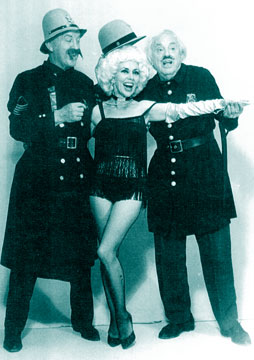
Striking a pose with Noble “Kid” Chisell and an unidentified blonde woman in April 1969. (Courtesy collection of Gilbert LeVeque)
The Kops maintained an active appearance schedule through the end of the decade. In addition, Eddie created several spin-off acts, including the Keystone Kops Dixieland Band, Sons of the Keystone Kops, the Kidstone Kops and the Keystone Kops Rockrollers. None of the spin-offs really clicked with the public, and were dropped fairly quickly. Eddie also explored the potential for having the Kops appear in cartoons and comics.
The December 1969 issue of The Eight Ball announced:
In association with Estudio Macian, S.A. of Barcelona, Spain, the Keystone Kops are being produced in several languages in cartoon film animation and comic strips. LeVeque, one of the best gag writers in show business, writes the comic strip gags and some of the animation stories.
The article also noted: “Two theater scripts, The Keystone Kops Capture Virginia Richmond and The Charge of the Keystone Kops, a stage musical and three originals by LeVeque are being adapted by other writers.”
In the early 1970’s, Eddie was still active with his new generation of Kops, sometimes performing with them at gatherings featuring the few surviving Keystone old-timers.
In 1972, Keystone’s most famous alumni, Charlie Chaplin, returned to America to receive an honorary Oscar from the Academy of Motion Picture Arts and Sciences. Getting in to see Chaplin at his hotel was almost impossible, but Eddie was determined to meet with Charlie. Eddie shared the details of how he got in to see Chaplin with Walter Wagner.
Even Charlie Chaplin, when he came back here a few years ago, remembered the Kops with great, great affection. He had two bungalows at the Beverly Hills Hotel, and he was seeing very few people. But when I called his secretary and said I was a Keystone Kop, she said, `Come on down. I’m sure Mr. Chaplin will see you.’ When I got to the hotel, there were dozens of reporters and photographers from all over the world trying to get to Chaplin. He wouldn’t see any of them. But I was ushered in. I showed him stills of the old Keystone Kops, and tears welled in his eyes. He told me, `I’m sorry that I never played in even one scene as a Keystone Kop. You boys were funnier than I ever was.’ (7.)
By the mid 1970’s old age finally began catching up with Eddie and he was forced to slow down. His final film role of note was a cameo appearance in the 1976 spoof Won Ton Ton, the Dog Who Saved Hollywood.
As he neared his 80th birthday, Eddie retired from the Keystone Kops and began appearing as a solo performer. In 1973, Eddie spoke about his solo career in great detail.
I make a lot of personal appearances and bill myself as the Last of the Keystone Kops. I work parades, nightclubs, theaters, fairs and benefits. The original Keystone Kops are as much a lovable historical curiosity today as Buffalo Bill was in the early 1900’s, when he had his Wild West Show. People just wanted to shake hands with him. People wanted to be able to tell their grandchildren, `I shook Buffalo Bill’s hand.’ It’s the same with me. When I appear in public, people shake my hand. They have their kids photographed with me. They ask for autographs. Men pump my arm off. Women hug and kiss me. But they aren’t hugging and kissing me. They are hugging and kissing history. The Kops still have that impact. (8.)
Eddie was still going strong as the 1970’s came to an end. Los Angeles magazine ran a profile on him in the April 1979 issue. The article reported that LeVeque “now spends a good deal of his time in costume—appearing in parades, emceeing community events and judging beauty contests. The Kop known as `Gags’ is still accepting movie roles and doing television commercials. `I guess by nature, I’m an exhibitionist, he says.’” (9.)
In 1986 two events occurred that forced Eddie into retirement. The first was the death of his beloved wife, Florence. The couple had been happily married for fifty-eight years and the loss was very hard for Eddie. Soon after, Eddie fell and suffered a broken hip. Unable to get around and in need of care, Eddie moved into the Hancock Park Convalescent Hospital.
His performing days now over, Eddie spent his final years of retirement at the hospital. He died there of natural causes at the age of 92 on January 29, 1989, and was laid to rest beside his wife Florence in Hollywood Memorial Park.
Years earlier, Eddie had expressed his beliefs and plans for the afterlife:
I was raised a Catholic and taught to believe that if you lived a good life, you would go to Heaven. You would go to Heaven and rest in peace. You would sit on a cloud and play a harp. But that Heaven sounds like a very tiresome place. In that sort of Heaven I’d be eternally bored. My goodness, I would rather, well, not exactly go to hell, but I’d like to be somewhere more active than that.
I’ll tell you one thing for sure. If Mack Sennett or some of the original Kops who are up there haven’t already done it, the first thing I’m going to do if and when I make it to Heaven is to start the Keystone Kops again. Never mind those harps. What a great time we’ll have chasing each other around from cloud to cloud. (10.)
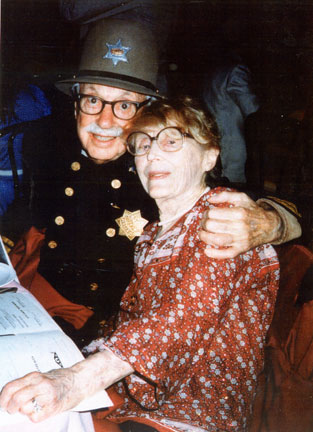
Eddie and his wife Florence together at a banquet in the early 1980s. (Courtesy of the author)
THE END
This concludes the two-part article.
Acknowledgments:
I would like to thank the following people for their invaluable help in piecing together the life and career of Eddie LeVeque: Faye Thompson at the Margaret Herrick Library for her support and assistance in guiding me through the massive Mack Sennett collection; film historians Sam Gill and Brent Walker for sharing their considerable knowledge of silent comedy; and most of all I wish to acknowledge and thank Gilbert LeVeque. Gilbert spent many hours helping me gain insight into his father’s career. It is through his generosity and kind permission that many photos from Eddie LeVeque’s personal scrapbook have been brought to light and published with my article.
The Writing Disorder would like to thank Steve Rydzewksi and his publication SLAPSTICK!,
where this article originally appeared.
Top photo: The author (right) with Eddie's son Gilbert LeVeque at Griffith Park during a recent visit to Los Angeles.
Michael Campino is a freelance writer and historian whose writings have frequently appeared in Slapstick! magazine. He has also contributed to and assisted in the production of numerous books and articles. A native of New York, Michael resides in the San Francisco Bay Area with his wife Deirdre, two daughters, and the family cat. He is currently doing research on the Mack Sennett Bathing Beauties for a projected series of articles.
ISSUE:
S P R I N G
2011
THE NEW
RULES OF
W R I T I N G
By accessing this site, you accept these Terms and Conditions.
Copyright © 2010-2011 TheWritingDisorder.com ™ — All rights reserved